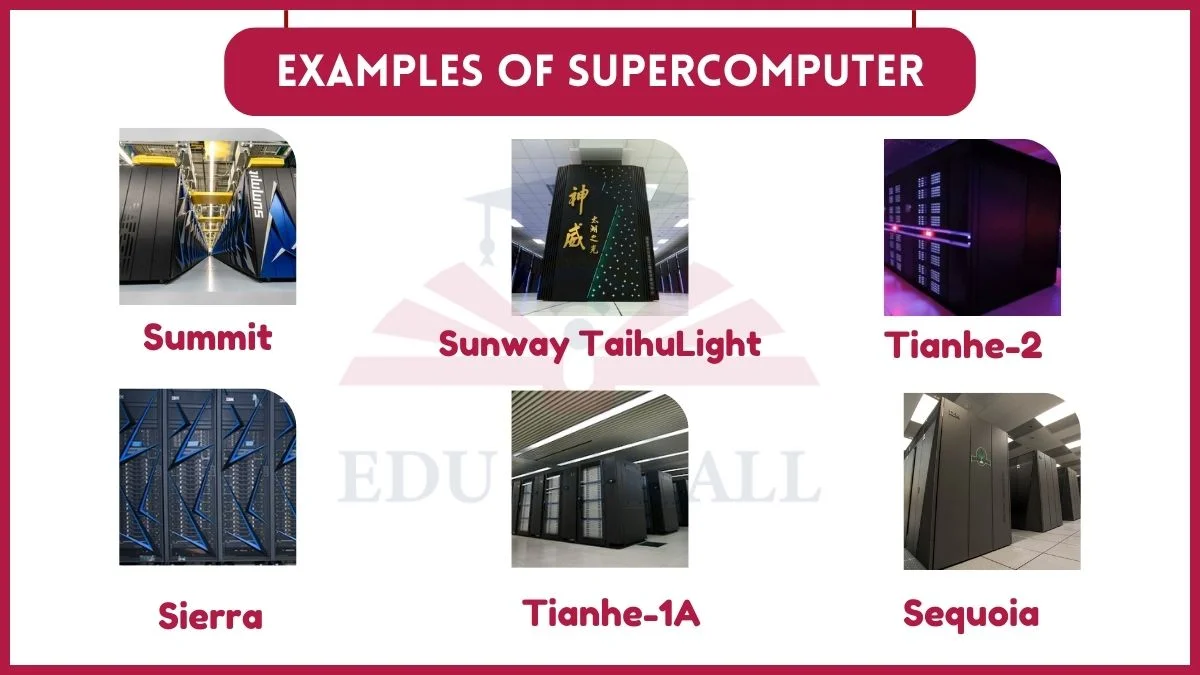Examples of supercomputers include Summit, Sunway TaihuLight, Tianhe-2, Fugaku, Tianhe-1A, Titan, and more.
A supercomputer is a computer system with extremely high performance capabilities, designed to solve complex computational problems.
Examples of Supercomputer
Here are the best examples of supercomputers:

1. Summit
Summit is an IBM-built supercomputer designed for use at Oak Ridge National Laboratory in Tennessee. With a peak performance of 148.8 petaflops. It is one of the fastest supercomputers in the world. Summit was specifically designed for machine learning and AI workflows in addition to traditional high-performance computing workloads.
2. Sunway TaihuLight
The Sunway TaihuLight is a Chinese supercomputer operated by the National Supercomputing Center. With a LINPACK benchmark rating of 93 petaflops. It was the world’s fastest supercomputer from June 2016 to June 2018. The Sunway TaihuLight system has over 10 million CPU cores.
3. Tianhe-2
Tianhe-2 is a Chinese supercomputer developed by China’s National University of Defense Technology. In June 2013, it set a record as the world’s fastest supercomputer with a performance of 33.86 petaflops. The system has over 3 million computing cores.
4. Fugaku
Fugaku is a Japanese supercomputer developed jointly by RIKEN and Fujitsu. In June 2020, it was ranked the world’s fastest supercomputer with a benchmark speed of 415.5 petaflops. Fugaku consists of 158,976 nodes, each with one 48-core A64FX processor.
5. Sierra
Sierra is a supercomputer at the Lawrence Livermore National Laboratory with a peak performance exceeding 125 petaflops. With 1.57 million compute cores, Sierra leverages IBM Power9 CPUs and NVIDIA Volta GPUs to enable high-performance simulations, deep learning, and more.
6. ABCI
ABCI is a 970 teraflops supercomputer built by Fujitsu for artificial intelligence and HPC workloads. It powers leading-edge AI research with 1,088 Radeon Instinct MI100 GPUs and high-speed interconnect for scalable training.
7. Tianhe-1A
The Tiahne-1A supercomputer deployed at China’s National Supercomputer Center in Tianjin operates at 2.57 petaflops, using 7,168 NVIDIA Tesla M2050 general-purpose GPUs and 14,336 Intel Xeon CPUs. Tianhe-1A was the world’s fastest supercomputer from October 2010 until 2011.
8. Trinity
Trinity is a Cray XC40 supercomputer operated by Los Alamos National Laboratory and delivers 40 petaflops of peak performance. It consists of 380,000 compute cores comprising Intel Xeon Phi 7250 (“Knights Landing”) processors. Trinity supports the National Nuclear Security Administration’s work in nuclear stockpile security.
9. Sequoia
An IBM BlueGene/Q system named Sequoia was deployed in 2012 at the Lawrence Livermore National Labs. Designed for advanced simulations of nuclear weapons performance. Sequoia operates at 20 petaflops sustained performance across 1.6 million cores. Sequoia’s 16-core Power processors are interconnected with five-dimensional torus networking.
10. Titan
Titan supercomputer deployed at Oak Ridge National Laboratory. Titan was rated at 17.6 petaflops and uses NVIDIA K20x GPU accelerators along with AMD Opteron CPUs to enable scientific applications at scale. At its launch in 2012, Titan had 560,640 compute cores and was the fastest supercomputer in the United States.

